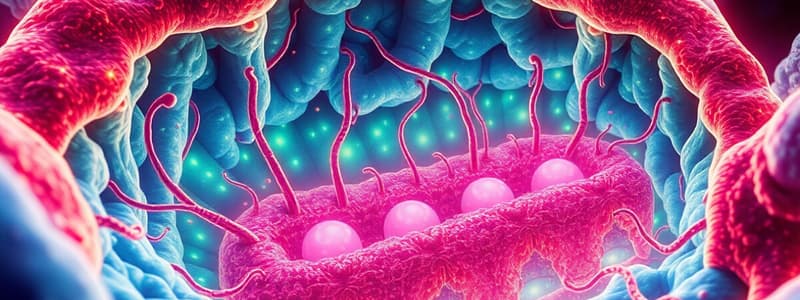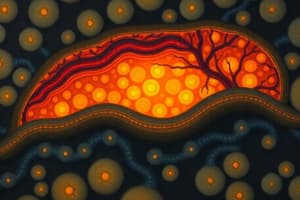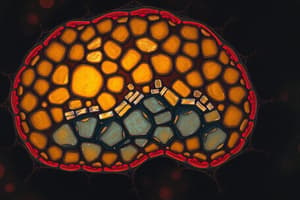Podcast
Questions and Answers
What is the primary function of the Rough ER in the endomembrane system?
What is the primary function of the Rough ER in the endomembrane system?
- Storage of energy molecules
- Transport of electrons
- Translation of mRNA to protein (correct)
- Waste recycling
Which part of the Golgi apparatus is primarily responsible for receiving incoming vesicles?
Which part of the Golgi apparatus is primarily responsible for receiving incoming vesicles?
- Trans face
- Cis face (correct)
- Lumen
- Periphery
What role do lysosomes play in the cell?
What role do lysosomes play in the cell?
- Store genetic material
- Synthesize energy
- Regulate protein synthesis
- Degrade biomolecules (correct)
What structural feature distinguishes the Smooth ER from the Rough ER?
What structural feature distinguishes the Smooth ER from the Rough ER?
How does the Golgi apparatus modify proteins?
How does the Golgi apparatus modify proteins?
What is the primary function of mitochondria within a cell?
What is the primary function of mitochondria within a cell?
Which structure is involved in the transformation of light energy into chemical energy?
Which structure is involved in the transformation of light energy into chemical energy?
What unique features support the endosymbiont hypothesis regarding mitochondria and chloroplasts?
What unique features support the endosymbiont hypothesis regarding mitochondria and chloroplasts?
What is the subunit that makes up microtubules in the cytoskeleton?
What is the subunit that makes up microtubules in the cytoskeleton?
Which structure in animal cells is responsible for providing cell-cell communication?
Which structure in animal cells is responsible for providing cell-cell communication?
What is one of the primary functions of the actin filaments in the cytoskeleton?
What is one of the primary functions of the actin filaments in the cytoskeleton?
Which statement accurately describes peroxisomes?
Which statement accurately describes peroxisomes?
What process do vacuoles mainly facilitate in damaged materials?
What process do vacuoles mainly facilitate in damaged materials?
Which component of the extracellular matrix provides structural support?
Which component of the extracellular matrix provides structural support?
Which type of cytoskeletal filament is primarily involved in chromosome movement during cell division?
Which type of cytoskeletal filament is primarily involved in chromosome movement during cell division?
What is the primary function of the Smooth ER within the endomembrane system?
What is the primary function of the Smooth ER within the endomembrane system?
Which statement accurately describes the structure of the Golgi apparatus?
Which statement accurately describes the structure of the Golgi apparatus?
What is the role of ribosomes on the Rough ER?
What is the role of ribosomes on the Rough ER?
What key process occurs within lysosomes?
What key process occurs within lysosomes?
In what manner do vesicles function within the Golgi apparatus?
In what manner do vesicles function within the Golgi apparatus?
What is the function of chlorophyll in chloroplasts?
What is the function of chlorophyll in chloroplasts?
What distinguishes the inner membrane of mitochondria?
What distinguishes the inner membrane of mitochondria?
Which type of cytoskeletal filament is primarily responsible for maintaining cell shape?
Which type of cytoskeletal filament is primarily responsible for maintaining cell shape?
What is a major function of desmosomes in animal cells?
What is a major function of desmosomes in animal cells?
Which evidence supports the endosymbiont hypothesis regarding organelles?
Which evidence supports the endosymbiont hypothesis regarding organelles?
What is the role of the extracellular matrix in animal cells?
What is the role of the extracellular matrix in animal cells?
What is the primary role of cristae in mitochondria?
What is the primary role of cristae in mitochondria?
What are the monomers that compose actin filaments?
What are the monomers that compose actin filaments?
What is the main function of peroxisomes within a cell?
What is the main function of peroxisomes within a cell?
Which of the following structures is involved in inter-cell exchange and communication?
Which of the following structures is involved in inter-cell exchange and communication?
Flashcards
Endomembrane system function
Endomembrane system function
A network of membranes within a eukaryotic cell that works together to synthesize, modify, package, and transport proteins and lipids.
Rough ER function
Rough ER function
Ribosome-studded part of the endoplasmic reticulum responsible for protein synthesis, mainly for proteins to be secreted or incorporated into membranes.
Golgi apparatus function
Golgi apparatus function
Organelle that processes, sorts, and packages proteins and lipids received from the ER for secretion or use within the cell.
Lysosome function
Lysosome function
Signup and view all the flashcards
ER structure
ER structure
Signup and view all the flashcards
Autophagy
Autophagy
Signup and view all the flashcards
Mitochondria function
Mitochondria function
Signup and view all the flashcards
Chloroplasts function
Chloroplasts function
Signup and view all the flashcards
Peroxisome function
Peroxisome function
Signup and view all the flashcards
Endosymbiotic hypothesis
Endosymbiotic hypothesis
Signup and view all the flashcards
Mitochondria structure
Mitochondria structure
Signup and view all the flashcards
Chloroplast structure
Chloroplast structure
Signup and view all the flashcards
Cytoskeleton function
Cytoskeleton function
Signup and view all the flashcards
Microtubule function
Microtubule function
Signup and view all the flashcards
Actin filament function
Actin filament function
Signup and view all the flashcards
Endomembrane system
Endomembrane system
Signup and view all the flashcards
Rough ER
Rough ER
Signup and view all the flashcards
Golgi apparatus
Golgi apparatus
Signup and view all the flashcards
Lysosomes
Lysosomes
Signup and view all the flashcards
Mitochondria's role
Mitochondria's role
Signup and view all the flashcards
Chloroplasts' role
Chloroplasts' role
Signup and view all the flashcards
Cytoskeleton's role
Cytoskeleton's role
Signup and view all the flashcards
Study Notes
Tour of the Cell 2
- The lecture covers the endomembrane system, protein trafficking, and metabolic functions within cells.
- The endomembrane system is like a cellular factory.
- The endoplasmic reticulum (ER) is responsible for production, biosynthesis and other functions.
- The rough ER has ribosomes attached, making proteins for secretion, and often glycosylating them.
- The smooth ER lacks ribosomes and produces lipids and hormones.
- The Golgi apparatus processes and packages proteins, and adds sugar chains to them, before, often exporting them to lysosomes.
- Vesicles transport materials within the cell.
Endoplasmic Reticulum (ER)
- The ER is a network of membranes within the cytoplasm.
- It has a large surface area, with a convoluted structure.
- The inside of the ER is called the lumen.
- The ER has specialized environments to control specific processes.
- ERs are of two types: smooth ER and rough ER.
- The rough ER is studded with ribosomes, aiding protein production.
- The smooth ER is responsible for lipid production, and lacks ribosomes.
Rough ER
- Ribosomes are attached to the rough ER.
- Ribosomes translate mRNA into proteins.
- Proteins produced by rough ER are often secreted out of the cell or are transported to other parts of the cell.
- Many proteins produced on the rough ER are glycosylated , which is adding sugars.
- Proteins are processed within the membrane of the rough ER.
- Leader signal polypeptides can target proteins to the ER.
- Proteins are integrated into the ER interior, where they are processed.
Golgi Apparatus
- The Golgi apparatus is a series of flattened sacs.
- It has a cis (receiving end) and trans (shipping end).
- Materials move from cis to trans within the Golgi.
- Sugars are added to proteins in the Golgi.
- Proteins are exported or directed to lysosomes.
- It is like a sorting and modification center for proteins in cells.
Lysosomes
- Lysosomes are sacs filled with hydrolytic enzymes.
- They are produced by the Golgi and involved in waste recycling.
- They degrade biomolecules and damaged materials.
- The enzymes in lysosomes are ready to degrade biomolecules.
- Lysosomes merge with vesicles from the outer (cell) membrane to digest material in phagocytosis.
- Lysosomes merge with vacuoles containing damaged materials in autophagy.
Energy Organelles - Mitochondria
- Mitochondria convert chemical energy into ATP.
- They have two membranes. The outer membrane is smooth, and the inner membrane is folded (cristae) to increase surface area.
- They contain their own DNA and ribosomes.
- Processes like respiration produce ATP, the cells' energy currency.
Energy Organelles - Chloroplasts
- Chloroplasts convert light energy into chemical energy (sugars).
- They have two membranes and thylakoids (internal membrane stacks).
- Thylakoids contain chlorophyll for photosynthesis.
- Chloroplasts contain their own DNA and ribosomes.
Energy Organelles - Peroxisomes
- Peroxisomes contain enzymes for chemical oxidation.
- They protect cells from toxic substances like hydrogen peroxide (H₂O₂).
- Peroxisomes are involved in alcohol detoxification.
Endosymbiotic Hypothesis
- Mitochondria and chloroplasts were once free-living prokaryotes (bacteria) that formed relationships with early eukaryotic cells.
- This theory explains why they have double membranes, their own DNA, and their unique ribosomes.
Mitochondria (detailed)
- Mitochondria have two membranes.
- The outer membrane is smooth.
- The inner membrane is folded into cristae to increase surface area.
- The spaces within are the intermembrane space and the matrix.
- Mitochondrial processes happen in these two spaces.
Chloroplasts (detailed)
- Chloroplasts also have two membranes.
- The thylakoids are inside, interconnected sacs.
- Grana are stacks of thylakoids.
- The stroma is the fluid around the thylakoids.
- The sites of photosynthesis are primarily in the stroma, thylakoid membranes contain chlorophyll.
Cytoskeleton
- The cytoskeleton maintains cell shape and enables cell movement.
- There are three types of cytoskeleton filaments: Microtubules, Actin filaments, and Intermediate filaments.
- Microtubules are hollow tubes, help maintain cell shape, are involved in cell division and cell motility.
- Actin filaments are solid rods, also helpful in cell shape, cell contraction and motility .
- Intermediate filaments are more diverse and also assist in cell structure, helping to withstand tension in anchoring structures.
- A variety of proteins interact with the cytoskeleton to direct the movement and actions of cell components.
Extracellular Connections
- Extracellular matrix is a complex of glycoproteins, carbs, and fibrous proteins.
- It provides structure and support for animal cells.
- Collagen, one major protein in the extracellular matrix, is a major part of the human protein matrix, making up nearly 40%.
- Integrins are cell surface proteins that connect cells to the extracellular matrix.
- Junctions between animal cells include tight junctions, desmosomes, and gap junctions.
- Tight junctions prevent leakage between cells.
- Desmosomes provide strong adhesion between cells.
- Gap junctions allow for intercellular communication.
Studying That Suits You
Use AI to generate personalized quizzes and flashcards to suit your learning preferences.




